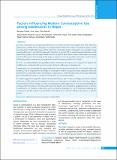Please use this identifier to cite or link to this item:
https://hdl.handle.net/20.500.14356/1532| Title: | Factors Influencing Modern Contraceptive Use among Adolescents in Nepal |
| Authors: | Subedi, Ranjeeta Jahan, Israt Baatsen, Pam |
| Citation: | SubediR., JahanI., & BaatsenP. (2018). Factors Influencing Modern Contraceptive Use among Adolescents in Nepal. Journal of Nepal Health Research Council, 16(3), 251-256. https://doi.org/10.33314/jnhrc.v16i3.1258 |
| Issue Date: | 2018 |
| Publisher: | Nepal Health Research Council |
| Article Type: | Review Article |
| Keywords: | Adolescent Barriers Contraceptive Nepal SRHR |
| Series/Report no.: | Jul-Sep 2018;1258 |
| Abstract: | Abstract In Nepal, contraceptive use among married adolescents is low and has remained nearly stagnant since 2006, while little information is available about contraceptive use among unmarried adolescents. Nepal is committed to improve sexual and reproductive health rights among all the adolescents. Promoting modern contraceptive use especially among married adolescents is one of the key approaches in practice, to prevent HIV or sexual transmitted infections, avoid unintended pregnancy and sub-sequent unsafe abortion. In spite of these efforts, modern contraceptive use among married adolescents is not increasing. In this study, we aimed to review the prevalence and trends as well as factors influencing modern contraceptive use among both married and unmarried adolescents in Nepal. A review of existing published and unpublished articles, documents, and reports were conducted. An adapted and modified socio-ecological model was used to explore the factors influencing contraceptive use. Contraceptive use is persistently low among adolescents. Various interrelated factors like socio-cultural norms and traditions, lack of comprehensive knowledge on contraceptive methods among adolescents, inadequate adolescent friendly Services and health workers not having the competencies to work with adolescents, are the major influential factors that limit adolescents to seek and use contraceptive services and information. A multilevel approach is required to address the interrelated factors and to create an enabling environment in which adolescent are fully informed and equipped to make use of contraceptives and related services. For this to happen, Government and NGOs working on sexual and reproductive health rights have to work towards translating the existing policies into practice. Involving adolescents, their families and communities; equipping teachers to provide comprehensive sex education within school and sex education programme for out of school and enhancing the competencies of health workers to provide adolescent friendly services – all in line with the written policy - is urgently needed. Keywords: Adolescent; barriers; contraceptive; Nepal; SRHR. |
| Description: | Review Article |
| URI: | http://103.69.126.140:8080/handle/20.500.14356/1532 |
| ISSN: | Print ISSN: 1727-5482; Online ISSN: 1999-6217 |
| Appears in Collections: | Vol. 16 No. 3 Issue 40 Jul - Sep 2018 |
Files in This Item:
| File | Description | Size | Format | |
|---|---|---|---|---|
| 1258-Manuscript-6613-1-10-20181030.pdf | Fulltext Article. | 214.26 kB | Adobe PDF |  View/Open |
Items in DSpace are protected by copyright, with all rights reserved, unless otherwise indicated.
